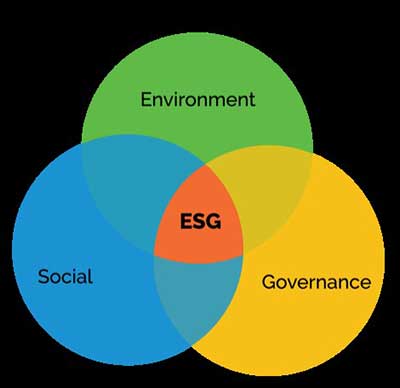Relevance: GS-3: Indian Economy and issues relating to Planning, Mobilization of Resources, Growth, Development and Employment.
Key Phrases: Credit-rating agencies, Securities and Exchange Board of India, Green-compliant, Socially conscious investors, “bluff sheets”, “selectively crafted”, Rating shopping, Conflict of interest.
Why in News?
- The Securities and Exchange Board of India (SEBI) has come out with a paper on how credit-rating agencies (CRAs) should go about ESG rating exercise. But wait. Some CRAs already have ESG grades for around 500-1,000 companies. Was that just a rudimentary exercise or has it been trivialized?
- Are you ESG compliant? This question will be asked of every company and is hence very important. The government is talking of issuing sovereign green bonds and the recipient of funds must be green-compliant. Foreign investors are keen to invest in ESG-complaint firms. This raises the question about what is ESG ratings, how it should be determined and what are the present challenges in this regard.
Background:
- Today, if one wants to see how a college is placed in the pecking order, one can get confused. Several ranking systems exist and their results are not consistent, especially if one excludes the top institutes. Now Environmental, Social and Governance (ESG) investing is the ‘next big thing’, with everyone talking of it.
- Investors (notably younger generations) have, in recent years, shown interest in putting their money where their values are. As a result, brokerage firms and mutual fund companies have started offering exchange traded funds (ETFs) and other financial products that follow ESG criteria.
What Are Environmental, Social, and Governance (ESG) Criteria?
Environmental, social, and governance (ESG) criteria are a set of standards for a company’s operations that socially conscious investors use to screen potential investments.
- Environmental criteria consider how a company performs as a steward of nature. It may include a company’s energy use, waste, pollution, natural resource conservation, and treatment of animals.
- Social criteria examine how it manages relationships with employees, suppliers, customers, and the communities where it operates. It looks at the company’s business relationships.
- Governance criteria deals with a company’s leadership, executive pay, audits, internal controls, and shareholder rights. Like how a company uses accurate and transparent accounting methods and those stockholders are allowed to vote on important issues.

Reality of ESG ratings in India:
ESG ratings have been assigned ostensibly based on the annual reports of companies. Sceptics suspect these self-write-ups could loosely be called “bluff sheets”, or, to be generous, “selectively crafted”.
- Environmental reality: While businesses say they have changed
bulbs and use auto switch-on/off power devices, how many have dispensed
with, say, bottled water?
- Private firms in particular make employees work well beyond office hours, which consumes a lot of power with large servers running overtime. These show how environmental care is missing in behaviour.
- Social reality: Every director’s report talks of how employees
are the most treasured resource.
- But during the pandemic, private companies with big reserves sacked employees or made them take pay cuts. Was this employee friendly?
- Labour forces are retrenched every now and then on grounds of enhancing shareholder value. Therefore, self-proclamations are often an eyewash.
- Governance reality: Typically, firms talk of their board
composition, number of independent and women directors and the count of
meetings attended.
- It is well known that in some owner-driven businesses, even reputed directors are mere dummies.
- How often have we heard of boards sacking incompetent and abusive chief executives? It’s very rare.
- Even through the recent crisis of the shadow-lending sector, directors were not blanked out from other boards. The recent episode of a stock exchange’s governance further weakens confidence.
Therefore, assigning ESG scores based on annual reports is fraught with risk, especially if these are to be used for critical investment decisions.
What is a Credit Rating Agency?
A credit rating agency does assessment of the financial strength of companies and other government entities. They help investors identify the company's status based on evaluation of their nature of work.
- All the credit rating agencies in India are regulated by Securities and Exchanges Board of India (SEBI). The credit rating agencies are monitored and reviewed by SEBI.
In India ESG ratings are done by credit-rating agencies (CRAs). So, can CRAs do this job? Only a measured answer is possible because the past does not inspire confidence.
Issues with CRA assessment:
- Issue with getting data from companies: The number of ‘Issuer not cooperating’ cases for surveillance has increased manifold. Once such firms procure a rating, their continued cooperation is not easy to obtain.
- Inherent conflict of interest: CRAs have subsidiaries which would do such ratings. Given that rating shopping is the order of the day, if a large company that pays a CRA, say, ₹5 crore in fees for a debt rating also asks for an ESG rating, risks of a compromise assessment cannot be ruled out.
- Little competence in evaluating environmental and social impacts: CRAs don't have expertise in this field like they have in financial areas. Therefore, a careful evaluation of all CRAs is necessary, and a blanket permission for the job would be inadvisable.
- Using artificial intelligence and machine learning for rating operations: It can be disastrous because algorithms will use annual-report data that can’t always be taken at face value. This should definitely not be permitted. Humans must decide ratings, not machines.
What is the way out?
- Specialized research institution: SEBI should mandate that this job be done by research institutions that specialize in ESG assessments.
- Selective involvement of CRA: If CRAs have to be involved, it should be selective. Those that have stood the test of time could be allowed, while others should be evaluated more seriously.
- Involving expert and specially qualified agency: It should insist that those who work on these ratings should be specially qualified for the task. An external rating panel with experts in these fields should be compulsory until the system stabilizes.
Conclusion:
- As we embark on an important journey of ESG ratings that also involves India’s government now, we need to ensure that no loose ends are left that can return to haunt us. We must keep in mind past episodes of failure in the rating industry for a strong edifice to be built.

- A slow beginning is better than rushing in and then finding it difficult to go back. The crypto case is a cautionary example; it seems hard to control crypto proliferation and there are only compromises being made.
Sources: Live mint
Mains Question:
Q. What Are Environmental, Social, and Governance (ESG) criteria? How India can benefit from ESG ratings and what reforms are required in Credit rating agencies to bring fair ESG ratings? [250 words].









